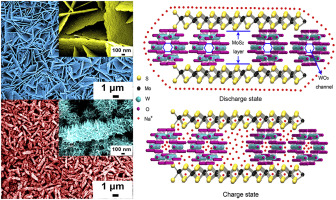Electrochimica Acta ( IF 6.6 ) Pub Date : 2018-01-12 , DOI: 10.1016/j.electacta.2018.01.072 Hanqin Gong , Feng Zheng , Jiahe Xu , Chencen Sun , Liangchao Gao , Pengfei Hu , Yang Li , Yu Gong , Qiang Zhen , Sajid Bashir

|
We first report a composite of molybdenum disulfide (MoS2) nanoflake arrays (MNFs) and tungsten trioxide (WO3) nanorod arrays (WNRs) directly grown on a copper (Cu) substrate. This composite is characterized in detail by scanning and transmission electron microscopes (SEM/TEM), X-ray diffraction (XRD), Raman and X-ray photoelectron spectroscopy (XPS). All of the evidences indicate that the obtained composite is a heterojunction. The supercapacitive properties of MNFs-WNRs composite heterojunction are measured systematically by using cyclic voltammetry (CV), galvanostatic charge-discharge (GCD) and electrochemical impedance spectroscopy (EIS) techniques. The heterojunction exhibits a high specific capacitance of 522 F g−1 at 0.5 A g−1, a high capacitance retention (95%) after 5000 cycles and a low charge transfer resistance (1.0 Ω). And this kind of heterojunction has advantages of both MoS2 and WO3, which can be a better candidate for supercapacitive electrode material.
中文翻译:

二硫化钼(MoS 2)纳米片阵列-三氧化钨(WO 3)纳米棒阵列复合异质结的制备及其超电容性能:一维和二维纳米材料的协同效应
我们首先报告直接在铜(Cu)衬底上生长的二硫化钼(MoS 2)纳米片阵列(MNFs)和三氧化钨(WO 3)纳米棒阵列(WNRs)的复合材料。通过扫描和透射电子显微镜(SEM / TEM),X射线衍射(XRD),拉曼光谱和X射线光电子能谱(XPS)对该复合材料进行详细表征。所有证据表明,所获得的复合材料是异质结。MNFs-WNRs复合异质结的超电容特性通过循环伏安法(CV),恒电流充放电(GCD)和电化学阻抗谱(EIS)技术进行系统地测量。异质结在0.5 A g -1时表现出522 F g -1的高比电容,5000次循环后的高电容保持率(95%)和低电荷转移电阻(1.0Ω)。这种异质结同时具有MoS 2和WO 3的优点,可以更好地用作超电容电极材料。



























 京公网安备 11010802027423号
京公网安备 11010802027423号